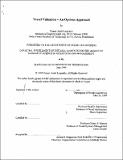Vessel valuation : an options approach
Author(s)
Largiadèr, Caspar Andri, 1965-
DownloadFull printable version (3.946Mb)
Other Contributors
Massachusetts Institute of Technology. Dept. of Ocean Engineering.
Advisor
Paul D. Sclavounos.
Terms of use
Metadata
Show full item recordAbstract
In the field of capital budgeting traditionally the widely accepted net-present-value (NPV) technique is used to capture a project's value. However, this approach fails to quantify managerial and operational flexibility and strategic interactions. The underlying analysis deals with the subject of resource allocation or capital budgeting under uncertainty, particularly with the valuation of managerial and operating flexibility as real options. Similar to options on financial assets, real options involve decisions or rights, with no obligation, to acquire or exchange an asset or project for a pre-specified price. Within the shipping industry the application of real options on operating vessels as strategic decision tools has so far been more or less neglected, since only few players are familiar with the option theory. A charterer operating a vessel may have an agreement with the owner to acquire the ship at some future date, giving him the option, without obligation, to do so. This flexibility to undertake a vessel acquisition provides the charterer with a certain value, depending on the movements of the market. This paper initially introduces the general option pricing theory applied to financial securities. Furthermore, an alternative way of modeling the stochastic nature of time charter. equivalent spot rates for the bulk freight market is presented. It is proposed to abandon the Geometric Brownian motion and, instead, to apply a mean reverting process, such as the OmsteinUhlenbeck process, to replicate the freight rates. Based on these findings, closed form option valuation tools are applied to a Panamax vessel type for one specific route, capturing the mean reverting character of the ship's cash flows. The results of the option valuation are discussed considering their practicability. Finally, recommendations for future research are given.
Description
Thesis (S.M.)--Massachusetts Institute of Technology, Dept. of Ocean Engineering, 1999. Includes bibliographical references (p. 74-75).
Date issued
1999Department
Massachusetts Institute of Technology. Department of Ocean EngineeringPublisher
Massachusetts Institute of Technology
Keywords
Ocean Engineering.